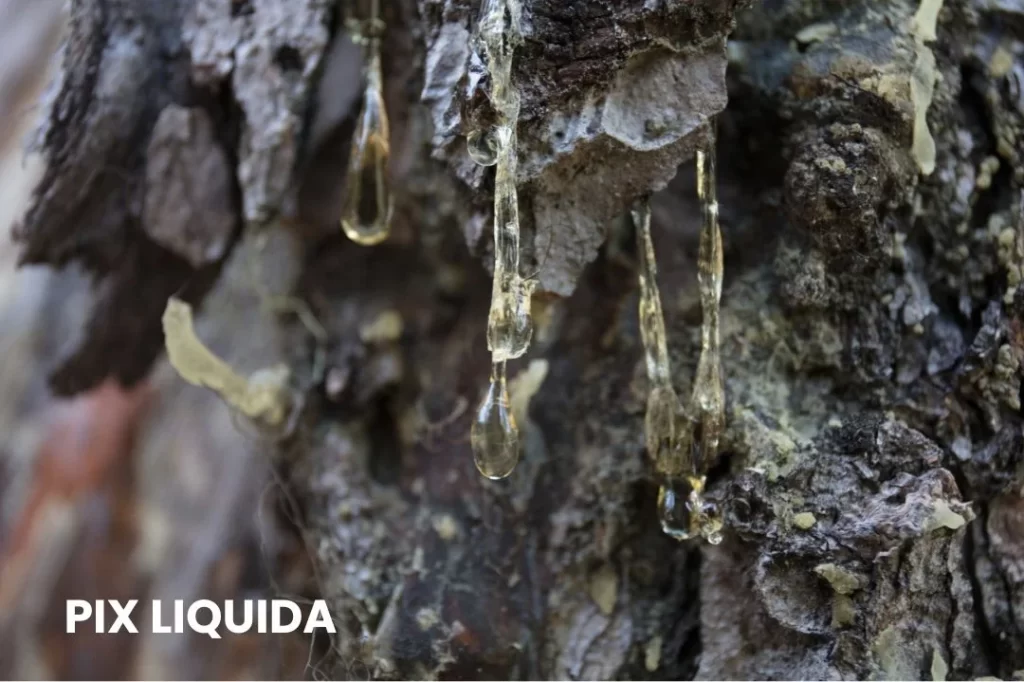Pix liquida, commonly known as pine-tar, is a dark, sticky substance obtained from the destructive distillation of pine wood.
It has been traditionally used for its medicinal properties, especially in treating respiratory and skin conditions.
Pine-tar acts on various mucous membranes and is particularly noted for its efficacy in treating bronchial irritation, chronic bronchitis, and skin ailments.

Table of Contents
ToggleSOURCE INFORMATION
Scientific Classification
- Kingdom: Plantae
- Order: Pinales
- Family: Pinaceae
- Genus: Pinus
- Species: Various species of pine trees (e.g., Pinus palustris, Pinus sylvestris)
Origin and Historical Facts
- Origin: Pine-tar is derived from the wood of pine trees, primarily through a process of destructive distillation where pine wood is heated in the absence of air to extract tar.
- Historical Usage: Pine-tar has been used for centuries in traditional medicine and various industries.
- Historically, it was employed as a treatment for skin diseases, wounds, and respiratory conditions.
- It was also used as a wood preservative and in shipbuilding to protect wood from rot.
- Medicinal Uses: In traditional medicine, pine-tar was used topically to treat eczema, psoriasis, and other skin conditions due to its antiseptic and anti-inflammatory properties.
- It was also used as an expectorant in respiratory ailments like bronchitis and cough.
DRUG PATHOGENESIS
- Pix liquida primarily acts on the skin and respiratory mucous membranes.
- It helps in reducing inflammation, alleviating itching, and treating chronic respiratory conditions.
- Its antiseptic properties make it effective in managing infections and promoting healing in various ailments.
KEY CHARACTERISTICS
- Respiratory System: Effective in treating bronchial irritation, chronic bronchitis, and cough. It helps in clearing mucopurulent sputum and alleviating pain in the chest.
- Skin: Treats scaly eruptions, intolerable itching, and cracked skin. It also helps in managing conditions like alopecia and various skin eruptions.
- Digestive System: Alleviates constant vomiting of blackish fluid accompanied by stomach pain.
DETAILED ORGAN SYMPTOMS
CHEST
- Pain: Notable pain at a specific spot around the third left costal cartilage where it joins the rib.
- Respiratory Symptoms: Presence of rales (abnormal rattling sounds) throughout the lungs, muco-purulent sputum with an offensive odor and taste, chronic bronchitis, and bronchial irritation after influenza.
SKIN
- Cracked Skin: Skin is dry, cracked, and bleeds upon scratching.
- Itching: Severe itching that becomes intolerable.
- Eruptions: Eruptions and scaly patches, particularly on the back of the hands.
DIGESTIVE SYSTEM
- Vomiting: Persistent vomiting of blackish fluid.
- Pain: Accompanied by stomach pain.
HAIR AND SCALP
- Alopecia: Hair loss (baldness).
MODALITIES
- Aggravation: Symptoms worsen with scratching and exposure to cold air.
- Amelioration: Symptoms improve with warmth and soothing applications.
WHAT ARE MODALITIES IN HOMOEOPATHY?
RELATIONSHIP WITH OTHER DRUGS
Comparisons: Pix liquida can be compared with its constituents and similar remedies, such as:
- Kreosotum (Kreosot): Used for bronchial irritation.
- Kali bichromicum (Kali bich): Effective for respiratory conditions.
- Petroleum (Petrol): Treats skin conditions.
- Pinus: Another remedy derived from pine trees.
- Eupion: Used for respiratory and skin ailments.
- Terebinthina (Terebinth): Used for urinary and respiratory conditions.
- Carbolic acid: Known for its antiseptic properties.
DOSE
- Potency: Pix liquida is typically used in potencies ranging from the first to sixth potency, depending on the specific symptoms and individual response.
Frequently Asked Questions
What is Pix liquida used for?
- Pix liquida is primarily used for treating respiratory conditions like chronic bronchitis and bronchial irritation.
- It is also effective in managing various skin conditions, including scaly eruptions, severe itching, and cracked skin.
Is Pix liquida safe to use?
- When used in recommended homeopathic potencies, Pix liquida is generally safe for most individuals.
- However, it is advisable to consult with a qualified homeopathic practitioner for proper dosage and administration.
What are the side effects of Pix liquida?
- Side effects are rare when used in homeopathic potencies.
- Inappropriate use or overdosing may lead to aggravation of symptoms or skin irritation.
Glossary of Difficult Words
- Alopecia: Hair loss, leading to baldness.
- Antiseptic: A substance that prevents the growth of disease-causing microorganisms.
- Bronchial: Relating to the bronchi, the major air passages of the lungs.
- Costal Cartilage: The cartilage that connects the ribs to the sternum (breastbone).
- Destructive Distillation: A process of heating organic material in the absence of air to break it down into simpler substances.
- Eczema: A medical condition causing inflamed, itchy, cracked, and rough skin.
- Expectorant: A medicine that helps bring up mucus and other material from the lungs.
- Influenza: A viral infection that attacks the respiratory system, commonly known as the flu.
- Mucous Membranes: The moist tissue lining certain internal organs and body cavities, such as the nose, mouth, and lungs.
- Mucopurulent: Containing both mucus and pus.
- Psoriasis: A skin disease marked by red, itchy, scaly patches.
- Rales: Abnormal rattling sounds heard in the lungs during a medical examination.
This comprehensive drug picture of Pix liquida provides a detailed overview of its uses, symptoms, and application in homeopathy, making it a valuable remedy for treating respiratory and skin conditions.
